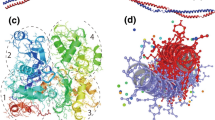Abstract
The effect of hypoxia on nucleated red blood cells of the black scorpionfish (Scorpaena porcus) was studied in vitro. Deep hypoxia (the oxygen concentration was less than 1 mg O2 L–1; the norm was 7–8 mg O2 L–1) led to the transition of a part of the hemoglobin molecules to the ferric state (methemoglobin). The maximum increase in the concentration of methemoglobin was 32%. The accumulation of methemoglobin in red blood cells was accompanied by an increase in the activity of catalase and superoxide dismutase and a decrease in the content of reactive oxygen species in the cytoplasm of cells. It was shown that the formation of methemoglobin did not cause damage to the cytoplasmic membranes of red blood cells. The percentage of red blood cell lysis in deoxygenated (less than 1.0 mg O2 L–1) suspensions quantitatively coincided with the control values.






Similar content being viewed by others
REFERENCES
A. N. Schechter, Blood 112 (10), 3927 (2008).
F. B. Jensen, A. Fago, and R. E. Weber, in Fish Physiology, Ed. by S. F. Perry and B. L. Tufts (Academic, San Diego, 1998), Vol. 17, pp. 1–40.
M. S. Krishna and G. Venkataramana, Ind. J. Physiol. Pharmacol. 51 (3), 284 (2007).
M. J. Percy and T. R. Lappin, Br. J. Haematol. 141, 298 (2008).
E. Mather-Mihaich, R. T. Di-Giulio, Arch. Environ. Contam. Toxicol. 20 (3), 391 (1991).
R. V. Zikic, A. Stajn, and V. M. Petrovic, Acta Biol. Jugosl. C 27 (1), 45 (1991).
C. S. Tucker and J. R. MacMillan, J. Appl. Aquacult. 1 (4), 21 (1992).
E. J. Schoore, B. A. Simco, and K. B. Davis, J. Aquat. Anim. Health. 7 (4), 304 (1995).
J. Wdzieczak, et al., Comp. Biochem. Physiol. B 73 (2), 361 (1982).
A. L. Dafre and E. Reischl, Comp. Biochem. Physiol. B 116 (3), 323 (1997).
J. Hardig and L. B. Hoglund, Comp. Biochem. and Physiol. A 76 (1), 27 (1983).
J. Sajiki and K. Takahashi, Eisei-Kagaku 37 (6), 467 (1991).
R. R. Wilson, Jr. and F. C. Knowles, Arch. Biochem. Biophys. 255, 210 (1987).
E. G. Affonso, et al., Comp. Biochem. Physiol. C. Toxicol. Pharmacol. 133 (3), 375 (2002).
N. Chen, et al., Frontiers Physiol. 8 (1), 1 (2017).
C. P. Olander and C. E. Parr, Experientia 33 (12), 1656 (1978).
J. Arnaud, et al., Ann. Human Biol. 6 (6), 585 (1979).
A. Mansouri, Experientia 37, 95 (1981).
W. G. Willmore and K. B. Storey, Mol. Cell. Biochem. 170, 177 (1997).
V. I. Lushchak and T. V. Bagnyukova, Comp. Biochem. Physiol. B 144, 283 (2006).
A. Stara, J. Machova, and J. Velisek, Neuroendocrinol. Lett. 33 (3), 130 (2012).
A. A. Soldatov, Hydrobiol. J. 41 (1), 113 (2005).
K. Tiihonen, M. Nikinmaa, J. Exp. Biol. 161, 509 (1991).
R. E. Benesch, R. Benesch, and S. Yung, Anal. Biochem. 55 (1), 245 (1973).
A. A. Soldatov, O. L. Gostyukhina, and I. V. Golovina, J. Evol. Biochem. Physiol. 44, 175 (2008).
R. G. Boutilier and R. A. Ferguson, Can. J. Zool. 67 (12), 2986 (1989).
M. C. L. Phillips, C. D. Moyes, and B. L. Tufts, J. Exp. Biol. 203 (6), 1039 (2000).
N. C. Adragna, M. Di Fulvio, and P. K. Lauf, J. Membrane Biol. 201 (3), 109. (2004).
W. J. Wallace, et al., J. Biol. Chem. 257, 4966 (1982).
M. F. Perutz, Annu. Rev. Physiol. 52, 1 (1990).
A. Soivio, K. Nyholm, and K. Westman, J. Fish Biol. 6 (6), 763 (1974).
M. Nikinmaa, et al., J. Exp. Biol. 47 (1), 53 (1987).
K. Holk, Fish Physiol. Biochem. 15 (5), 371 (1996).
B. Tufts, Can. J. Zool. 70 (3), 411 (1992).
R. A. Ferguson and R. G. Boutilier, Respir. Physiol. 74 (6), 65 (1988).
A. Salama and M. Nikinmaa, Raporttisar. Mat.-Luonnontieteenllis. Tiedekunnan / Joensuun Gliopisto 30, 13 (1991).
A. L. Val, G. C. De Menezes, and C. M. Wood, J. Fish Biol. 52 (1), 83 (1997).
A. Y. Andreyeva, A. A. Soldatov, and V. S. Mukhanov, In vitro Cell. Dev. Biol. Anim. 53 (4), 312 (2017).
A. White, P. Handler, and E. L. Smith, Principles of Biochemistry (McGraw-Hill, 1978), Vol. 3.
J. N. Cameron, Comp. Biochem. Physiol. A 40 (3), 743 (1971).
A. A. Soldatov and I. A. Parfenova, J. Evol. Biochem. Physiol. 37 (6), 622 (2001).
Funding
This work was performed within the framework of the State Task, State Registration no. AAAA-A18-118021490093-4; and with partial financial support of the Russian Foundation for Basic Research, project no. 16-04-00135.
Author information
Authors and Affiliations
Corresponding author
Ethics declarations
CONFLICT OF INTEREST
The authors declare that there is no conflict of interest.
COMPLIANCE WITH ETHICAL STANDARDS
All applicable international, national and institutional principles for the care and use of animals in the performance of work have been observed.
Additional information
Translated by E. Puchkov
Abbreviations: Hb, hemoglobin; HbO2, oxyhemoglobin; MtHb, methemoglobin; NADH, nicotinamide adenine dinucleotide (reduced); CAT, catalase; SOD, superoxide dismutase; ROS, reactive oxygen species.
Rights and permissions
About this article
Cite this article
Soldatov, A.A., Andreeva, A.Y., Kukhareva, T.A. et al. Methemoglobin and the Activities of Catalase and Superoxide Dismutase in Nucleated Erythrocytes of Scorpaena porcus (Linnaeus, 1758) under Experimental Hypoxia (in vitro). BIOPHYSICS 65, 452–459 (2020). https://doi.org/10.1134/S0006350920030197
Received:
Revised:
Accepted:
Published:
Issue Date:
DOI: https://doi.org/10.1134/S0006350920030197




